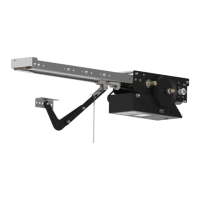13
6 Electrical Wiring
WARNING
To reduce risk of SEVERE INJURY or DEATH to persons:
• All electrical wiring should be permanent and should be done by a qualified professional
and in accordance to local electrical codes.
• Always shut OFF the main power before performing any electrical intervention.
• Use proper wire gauge for incoming power line. Use copper conductors only.
• Use cable type CL2, CL2P, CL2R, or CL2X complying with the Standard “UL13 - Power-
Limited Circuit Cables” for accessory connections.
• Install operator main circuit breaker next to operator for easy access for power shut-off.
• Use separate knockouts on operator control box for accessories and main power cables.
• Always separate low and high voltage wires.
• Operator should be properly grounded to the building ground and to the main power
supply ground lug.
• Always use suitable and appropriate rating circuit breakers for operator protection.
• Compare available power supply voltage to voltage on operator name plate prior to
electrical connection. Failure to connect appropriate power supply voltage may cause
serious damage to the operator.
NOTICE
• THE OPERATOR MUST BE ADEQUATELY PROTECTED AGAINST OVERCURRENT AND SHORT-
CIRCUIT.
• PLEASE REFER TO LOCAL ELECTRICAL CODE.
• PLEASE REFER TO NATIONAL ELECTRIC CODE (NFPA 70) ARTICLE 430 SECTION IV (430.51 /
430.52 / 430.53).
• PLEASE REFER TO CANADIAN ELECTRIC CODE (CSA 22.1) SECTIONS 28-200 / 28-206.
Guideline to determine the branch-circuit rating of the protective device [A]:
Time Delay Fuse: 1.75 x FLA
Non-Time Delay Fuse: 3.0 x FLA
A fuse, which does not exceed the next standard amperage value, shall be permitted.
Example: If FLA = 5.0A
• Time Delay Fuse: 1.75 x 5.0A = 8.75A → Standard fuse to use: 10A
• Non-Time Delay Fuse: 3.0 x 5.0A = 15.0A → Standard fuse to use: 15A
For technical support, please call 1-800-4-Raynor (1-800-472-9667) or visit www.raynor.com
FLA = Full Load Amp

